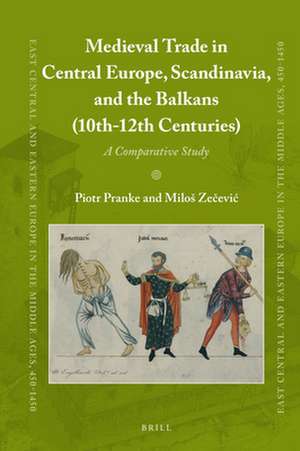Medieval Trade in Central Europe, Scandinavia, and the Balkans (10th-12th Centuries): A Comparative Study: East Central and Eastern Europe in the Middle Ages, 450-1450, cartea 64
Autor Piotr Prankeen Limba Engleză Hardback – 12 aug 2020
In the historiography of trade in the Middle Ages, there is a wide current of theoretical consideration referring to the ways contemporaries perceived trade. The present work pays specific attention to how trade functioned within the range of the influence of the Ottonian Empire and Byzantium, from the 10th to 12th centuries. This book attempts to verify these concepts in the extensive available source. The manner of circulation of goods and the phenomenon of accumulating goods is a significant product of the present book, demonstrating how imperial influences that perceived through the prism of generative centres on the peripheries of Europe. This volume is the English translation of Handel interregionalny od X do XII wieku. Europa Środkowa, Środkowo-Wschodnia, Pólwysep Skandynawski i Pólwysep Balkański. Studium Porównawcze (Wydawnictwo Naukowe Uniwersytetu Mikolaja Kopernika, Torun 2016).
Din seria East Central and Eastern Europe in the Middle Ages, 450-1450
- 18%
 Preț: 800.46 lei
Preț: 800.46 lei - 18%
 Preț: 743.33 lei
Preț: 743.33 lei - 18%
 Preț: 1022.29 lei
Preț: 1022.29 lei - 18%
 Preț: 1176.15 lei
Preț: 1176.15 lei - 18%
 Preț: 731.25 lei
Preț: 731.25 lei - 18%
 Preț: 730.01 lei
Preț: 730.01 lei - 18%
 Preț: 893.05 lei
Preț: 893.05 lei - 18%
 Preț: 1010.45 lei
Preț: 1010.45 lei - 18%
 Preț: 1223.50 lei
Preț: 1223.50 lei - 18%
 Preț: 1048.15 lei
Preț: 1048.15 lei - 18%
 Preț: 940.83 lei
Preț: 940.83 lei - 18%
 Preț: 976.42 lei
Preț: 976.42 lei - 18%
 Preț: 940.07 lei
Preț: 940.07 lei - 18%
 Preț: 776.92 lei
Preț: 776.92 lei - 18%
 Preț: 648.08 lei
Preț: 648.08 lei - 18%
 Preț: 631.60 lei
Preț: 631.60 lei - 18%
 Preț: 709.54 lei
Preț: 709.54 lei - 18%
 Preț: 1055.16 lei
Preț: 1055.16 lei - 18%
 Preț: 1320.28 lei
Preț: 1320.28 lei - 18%
 Preț: 545.07 lei
Preț: 545.07 lei - 18%
 Preț: 814.51 lei
Preț: 814.51 lei - 18%
 Preț: 793.91 lei
Preț: 793.91 lei - 18%
 Preț: 695.49 lei
Preț: 695.49 lei - 18%
 Preț: 525.08 lei
Preț: 525.08 lei - 18%
 Preț: 707.77 lei
Preț: 707.77 lei - 18%
 Preț: 706.81 lei
Preț: 706.81 lei - 70%
 Preț: 625.11 lei
Preț: 625.11 lei - 18%
 Preț: 1540.16 lei
Preț: 1540.16 lei - 18%
 Preț: 851.46 lei
Preț: 851.46 lei - 18%
 Preț: 826.36 lei
Preț: 826.36 lei - 18%
 Preț: 670.69 lei
Preț: 670.69 lei - 18%
 Preț: 817.49 lei
Preț: 817.49 lei - 18%
 Preț: 871.88 lei
Preț: 871.88 lei - 64%
 Preț: 715.27 lei
Preț: 715.27 lei - 18%
 Preț: 819.97 lei
Preț: 819.97 lei - 18%
 Preț: 849.51 lei
Preț: 849.51 lei - 18%
 Preț: 954.10 lei
Preț: 954.10 lei - 18%
 Preț: 1089.95 lei
Preț: 1089.95 lei - 15%
 Preț: 428.32 lei
Preț: 428.32 lei - 18%
 Preț: 730.47 lei
Preț: 730.47 lei - 18%
 Preț: 878.41 lei
Preț: 878.41 lei - 18%
 Preț: 730.01 lei
Preț: 730.01 lei - 18%
 Preț: 760.53 lei
Preț: 760.53 lei - 18%
 Preț: 636.93 lei
Preț: 636.93 lei - 18%
 Preț: 908.17 lei
Preț: 908.17 lei - 18%
 Preț: 882.32 lei
Preț: 882.32 lei - 18%
 Preț: 920.99 lei
Preț: 920.99 lei - 18%
 Preț: 577.99 lei
Preț: 577.99 lei - 18%
 Preț: 1323.50 lei
Preț: 1323.50 lei - 18%
 Preț: 1130.38 lei
Preț: 1130.38 lei
Preț: 611.93 lei
Preț vechi: 746.26 lei
-18% Nou
117.09€ • 122.25$ • 96.91£
Carte indisponibilă temporar
Specificații
ISBN-10: 9004380337
Pagini: 264
Dimensiuni: 155 x 235 mm
Greutate: 0.84 kg
Editura: Brill
Colecția Brill
Seria East Central and Eastern Europe in the Middle Ages, 450-1450
Cuprins
Abbreviations
Introduction
1 Theories of Socioeconomic Impact: From Immanuel Wallerstein’s ‘World Systems’ to Kondratiev/Schumpeter Waves
1.1 World Systems Analysis: From Business Cycles to Ancient World Theory
1.2 Central Place Theory, Gateway Cities, Break-In Transportation Theory: an Outline
1.3 Substantivism and Formalism: a Dispute over the Importance of Economic Phenomena in the Past
2 Trade in the Period from the 10th to the 12th Centuries: Merchants during the Early and High Middle Ages
2.1 Who Are the Merchants?
2.2 Those Who Come and Go: the Idea of an Itinerant Market
2.3 Fair Trading
2.4 The Customs Duty System: Just and Fair Duty
3 The Scandinavian Peninsula and the Balkan Peninsula: a Comparative Analysis
3.1 Scandinavian Economic Penetration in the Light of Sources of North European Provenance
3.2 Scandinavian Economic Penetration in the Light of Oriental Sources
3.3 Trade on the Balkan Peninsula Territory
3.4 Production and Dependent Population: an Example of the Balkan Peninsula
4 Goods That Were Exchanged in Trade
Appendix: A Source Study: High Medieval Market Institutions—“ut nullus teloneum exigat nisi in mercatibus ubi communia commertia emuntur ac venundantur”
List of Customs Privileges in Post-Carolingian Europe (10th–12th Century)
List of Mint Privileges in the Post-Carolingian Europe (10th–12th Century)
List of Market Privileges for the Post-Carolingian Europe (10th–12th Century)
Trade Privileges in the Balkans
Conclusions
Bibliography
Index
Notă biografică
Milos Žečević is a PhD student in History at (Uniwersytet Kazimierza Wielkiego w Bydgoszczy / Kazimierz the Great Univeristy) UKW in Bydgoszcz, Poland. He has published monographs, and many articles in Polish, Serbian and English. He is interested in dependent population in the Balkans in the Middle Ages.
